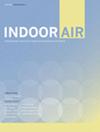Molecular Characteristics, Sources, and Health Risk Assessment of Gaseous Carbonyl Compounds in Residential Indoor and Outdoor Environments in a Megacity of Northwest China
IF 4.3
2区 环境科学与生态学
Q1 CONSTRUCTION & BUILDING TECHNOLOGY
引用次数: 0
Abstract
Carbonyl compounds (CCs) in indoor air pose a significant threat to residents’ health and have garnered considerable attention in recent years. However, most studies have focused on low-molecular-weight carbonyl compounds (LMW-CCs) and have underestimated the impact of high-molecular-weight ones (HMW-CCs), causing a failure to comprehensively understand their effects on health. In this study, we analyzed twenty carbonyls in the indoor and outdoor air at typical residential communities in a megacity in Northwest China by using high-performance liquid chromatography (HPLC) coupled with a photodiode array detector (DAD). The total concentration of indoor carbonyls was 1.4-3.4 times that of outdoor carbonyls. In addition, the concentration of indoor carbonyls was much higher during the heating season than that during the nonheating season. Conversely, the concentration of outdoor carbonyls was higher during the nonheating season than that during the heating season. The principal component analysis (PCA) revealed that indoor carbonyl pollution was primarily influenced by building materials, cooking fume, and wooden furniture. Formaldehyde exposure in indoor environments posed a greater health risk to children than acetaldehyde exposure. HMW-CCs were the primary contributors to indoor odor pollution, which was considered a significant cause of sick building syndrome (SBS). Our findings underscore the crucial role of HMW-CCs in indoor environments in exerting adverse impacts on health.西北特大城市住宅室内外环境中气态羰基化合物的分子特征、来源及健康风险评价
室内空气中的羰基化合物对居民健康构成严重威胁,近年来引起了人们的广泛关注。然而,大多数研究都集中在低分子量羰基化合物(lmw - cc)上,低估了高分子量羰基化合物(hmw - cc)的影响,导致未能全面了解它们对健康的影响。本研究采用高效液相色谱法(HPLC)结合光电二极管阵列检测器(DAD)对西北某特大城市典型住宅小区室内和室外空气中的20种羰基进行了分析。室内羰基的总浓度是室外羰基的1.4 ~ 3.4倍。此外,采暖季室内羰基浓度明显高于非采暖季。相反,非采暖季室外羰基浓度高于采暖季。主成分分析表明,室内羰基污染主要受建筑材料、烹饪油烟和木制家具的影响。室内环境中的甲醛暴露比乙醛暴露对儿童的健康风险更大。hmw - cc是室内气味污染的主要来源,被认为是病态建筑综合征(SBS)的重要原因。我们的研究结果强调了室内环境中hmw - cc对健康产生不利影响的关键作用。
本文章由计算机程序翻译,如有差异,请以英文原文为准。
求助全文
约1分钟内获得全文
求助全文
来源期刊

Indoor air
环境科学-工程:环境
CiteScore
10.80
自引率
10.30%
发文量
175
审稿时长
3 months
期刊介绍:
The quality of the environment within buildings is a topic of major importance for public health.
Indoor Air provides a location for reporting original research results in the broad area defined by the indoor environment of non-industrial buildings. An international journal with multidisciplinary content, Indoor Air publishes papers reflecting the broad categories of interest in this field: health effects; thermal comfort; monitoring and modelling; source characterization; ventilation and other environmental control techniques.
The research results present the basic information to allow designers, building owners, and operators to provide a healthy and comfortable environment for building occupants, as well as giving medical practitioners information on how to deal with illnesses related to the indoor environment.
 求助内容:
求助内容: 应助结果提醒方式:
应助结果提醒方式:


